Still hanging around? Okay… here’s the revision story. Last Friday, the UPS guy came with one of those big, thick, daunting envelopes. My editor at Walker had already emailed to let me know the second round of revisions for my December 2010 middle grade novel SUGAR ON SNOW were on the way. I love revision, but opening that envelope this time threw me for a bit of a loop at first. This revision feels bigger than the first one, and I have less than a month to turn it around if we’re to make copy edits on time. But the more I read over the letter and thought about it, the more excited I got. What editor MK is suggesting is exactly what this book needs to get to the next level…to get ME to where I want to be as a writer.
The revisions fall into two main categories — making relationships between characters deeper and stronger (and there are a lot of characters in this book!) and establishing a better balance between the main character’s home/school life and her ice skating world. Here’s what my revision process has been looking like so far.
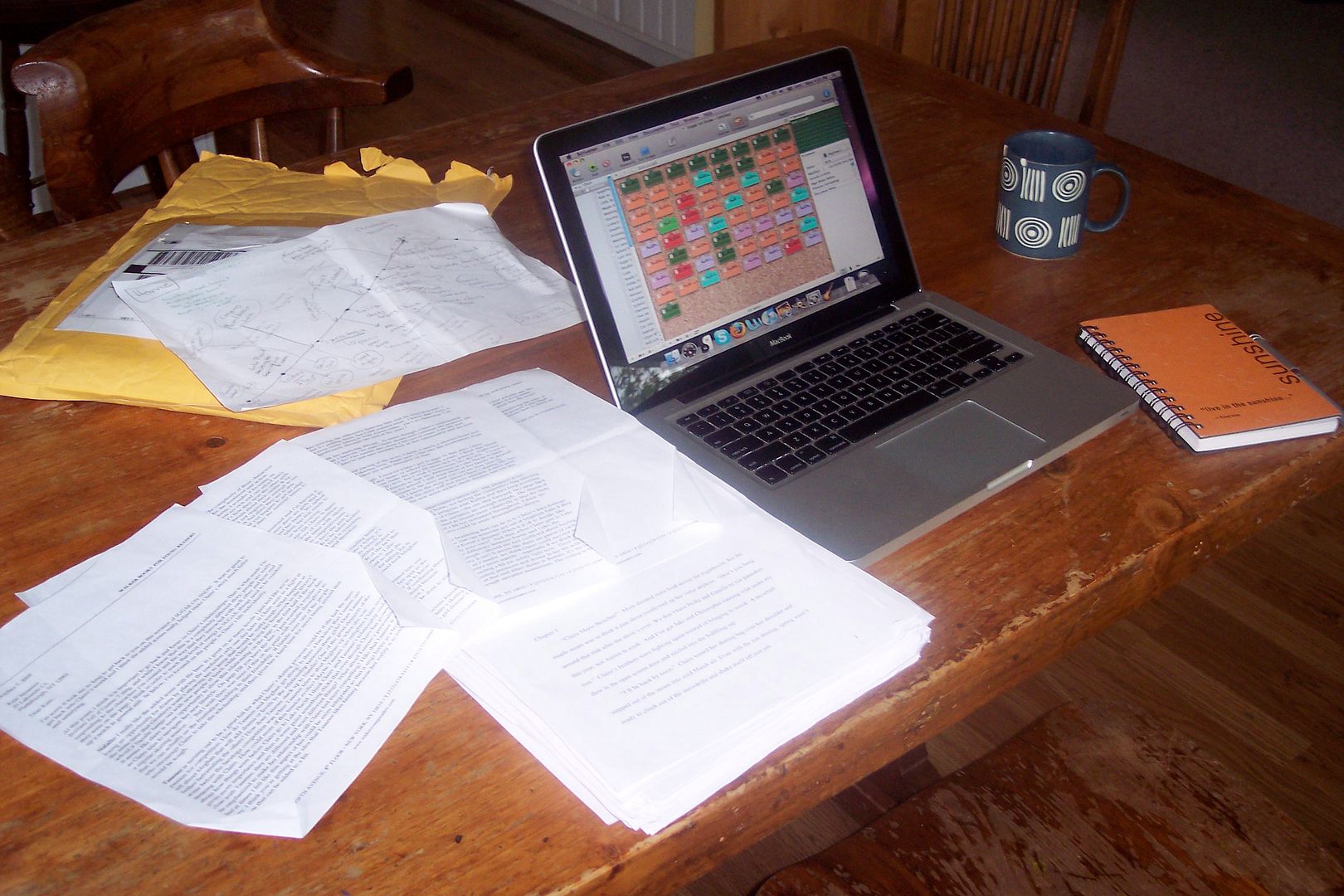
There’s the usual green tea, notebook, laptop, manuscript, & revision letter. That paper up on the envelope is actual a plot diagram that editor MK created showing the book’s main plot points leading up to the climax. I’m not showing a closeup because it’s kind of spoilery, but I’ll tell you what it looks like. So I could better understand the balance issue, MK put the plot points that relate to ice skating under the timeline and the home/school stuff over the line. It’s about an 80/20 division right now, heavy on the skating, and I agree with her that it would be stronger if it were more like 60/40.
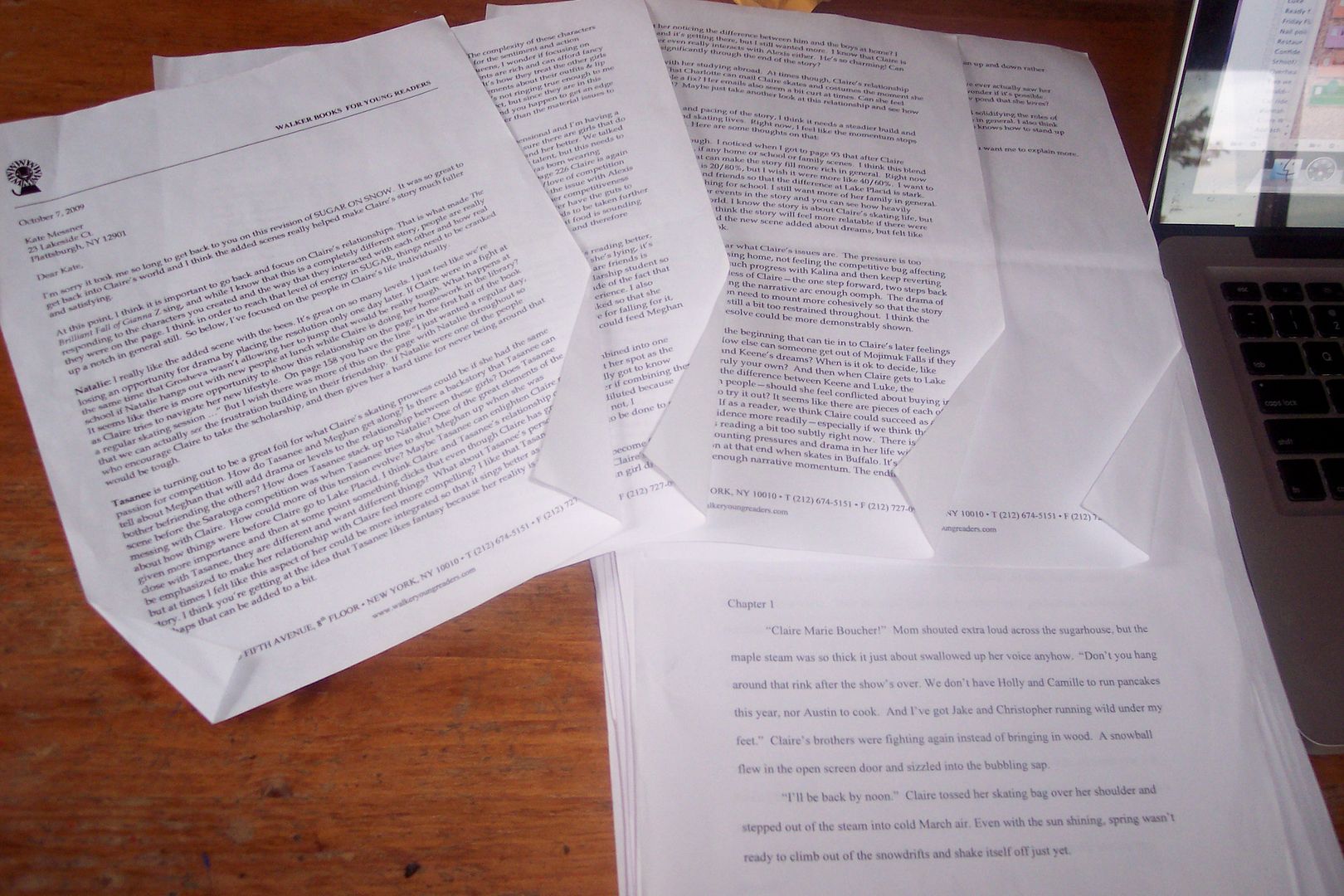
This second editorial letter is four pages long, almost all focusing on individual character development and relationships. Good stuff.
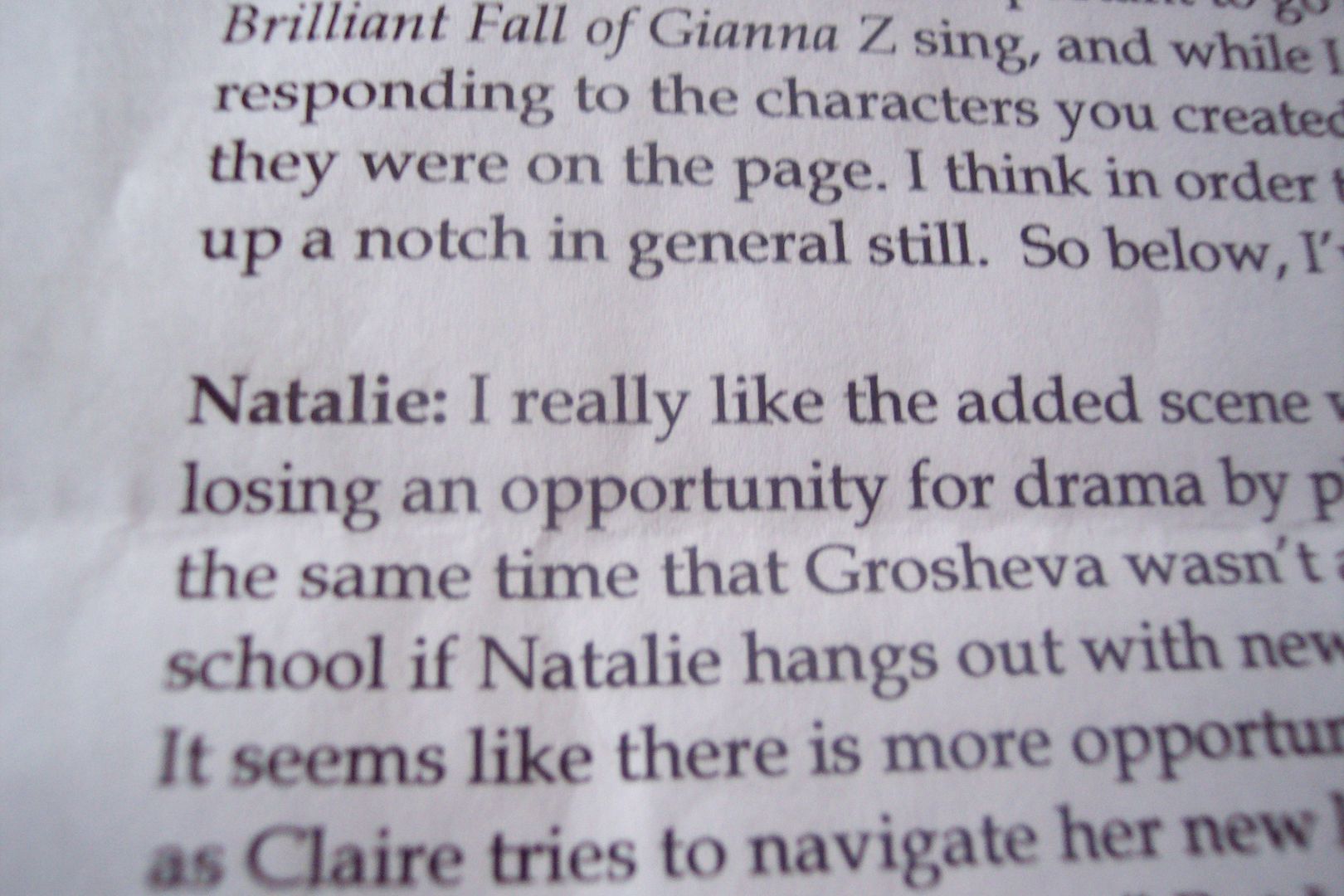
I’m doing most of that work off the computer…right here.

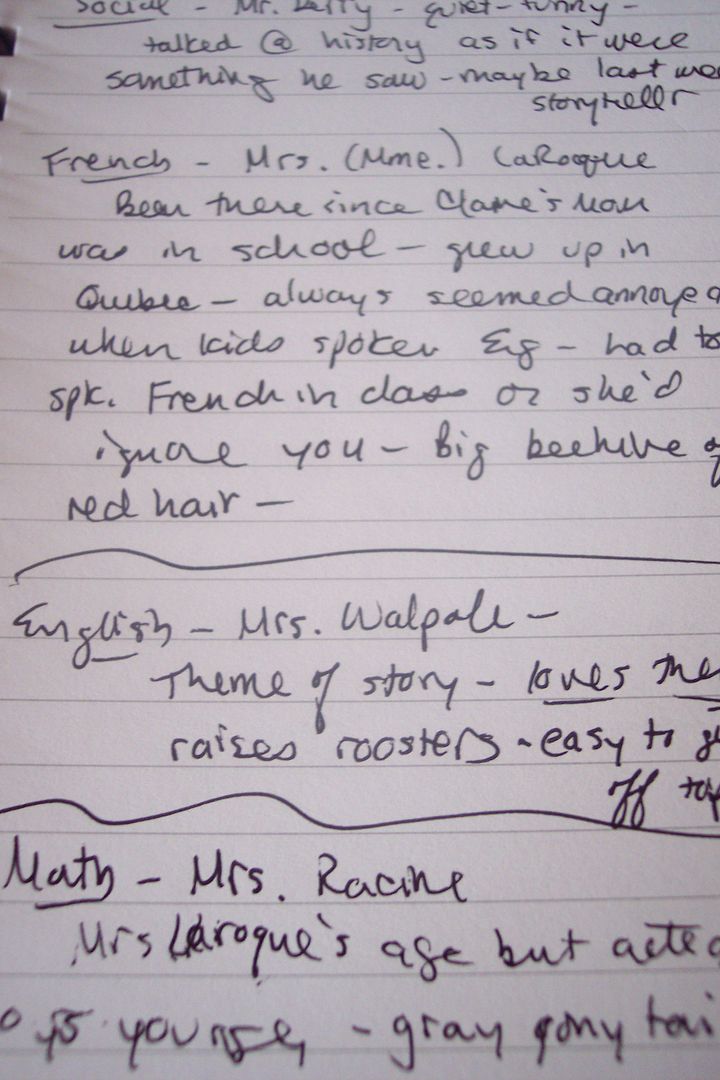
This is one of those pricey notebooks with a thick cover that I bought for 80% off at a little paper goods store in SoHo on one of my authory trips to NY. I saved it for a time when I needed a special notebook that made me extra excited to write, and when I first felt overwhelmed reading that editorial letter, I knew that it was time to pull it out. I’ve been doing everything I can to develop the main character, Claire, more as a student and friend. I just finished character sketches of every one of her 7th and 8th grade teachers. I’m not sure yet which of those will make it into the new draft, but I know them now.
When I went back to the actual novel to start working on the computer again, the first thing I did was bring it scene by scene into Scrivener, the new writing software I started using after I finished this book.
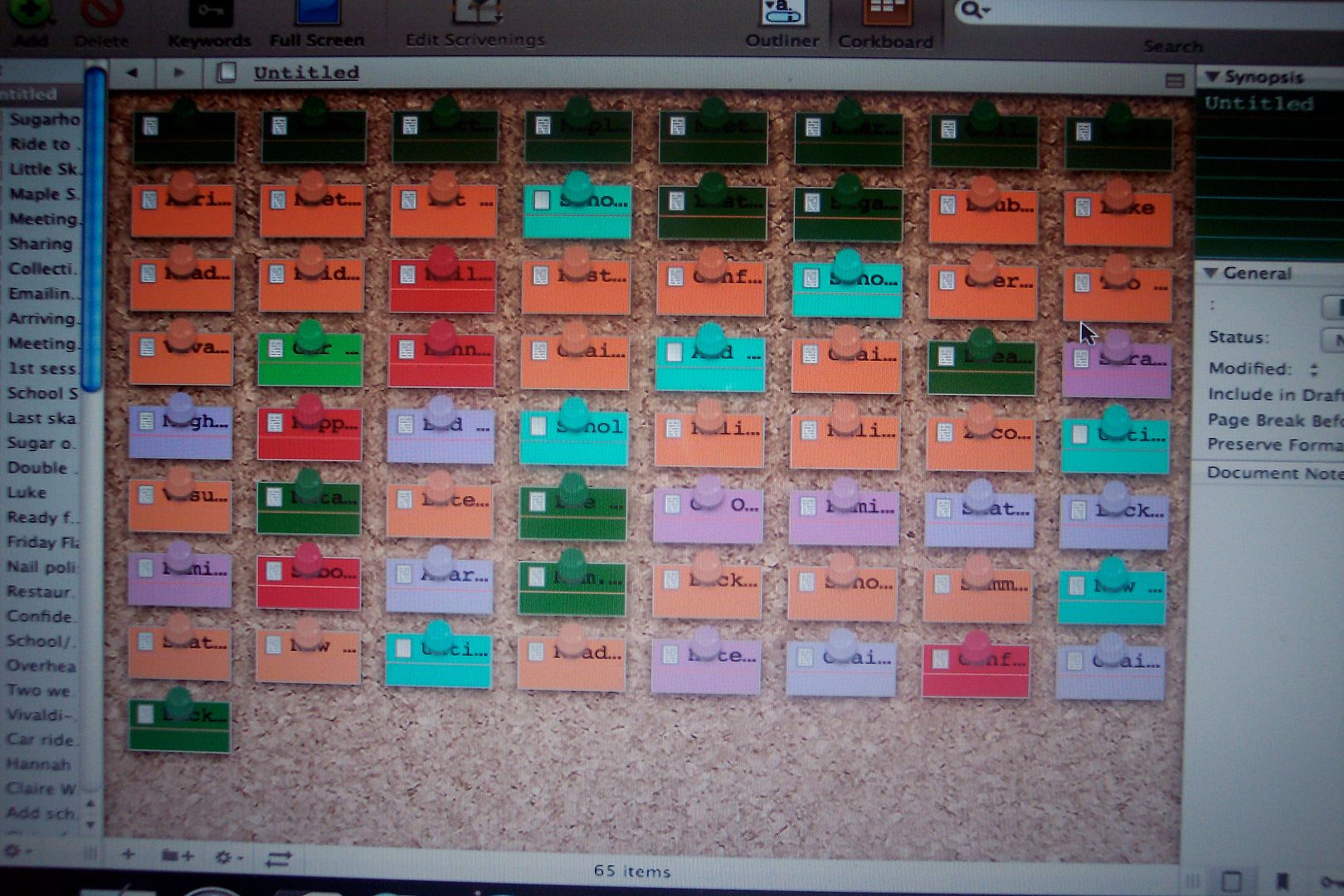
See the colored index cards on my virtual bulletin board? The green ones represent scenes that focus on Claire’s family & home life. The orange ones represent skating scenes in Lake Placid and the lavender ones are competition scenes. (The red ones are important but are sort of a secret – sorry.) And the turquoise ones are school scenes. But here’s the thing… When I first set this up, there were only two turquoise cards. The others are blank scenes that I’ve added over the past few days – placeholders for the new school scenes that I’m going to write to help with the balance issue. I love that Scrivener lets you “see” the whole manuscript in such a conceptual way – it really helps me at times like this.
Interestingly enough, it was in thinking through one of those new school scenes that I came up with a way to build on one aspect of my main character that I’d sort of alluded to but didn’t really develop fully in the earlier drafts. It’s going to be really, really fun, so I’m saving the work on that thread for after I’ve tackled some of the new scenes that are going to be a little tougher to muddle through. I’ll do that sometimes – use the fun stuff as a reward for sticking it out through the hard stuff.
I don’t save the easy stuff, though, interestingly enough. The little line edits and quick fixes? I do those first for a couple reasons. If I wait too long and have made major changes, it’s harder to find those line edits to make the changes. And also, accomplishing some small jobs helps me to ease back into a manuscript and feel competent in that world again, so that when I tackle the bigger issues, I’m able to do so with more confidence.
You may not hear a whole lot from me, blog-wise, until this revision is done, so I’ll leave you to continue the conversation. What works for you when you’re tackling a big revision? How do you break up the job so it doesn’t feel overwhelming? Any unusual strategies that have led to breakthroughs? Go ahead….talk amongst yourselves… I’ll try to stop by with some tea later on.





Very interesting. I love reading about the writing process–though I do think your index cards look a bit too neat
Good luck with the revisions.
Oh, thank you so much for sharing this! It’s always fascinating to me to read about authors’ processes because I’m still muddling about trying to discover my own. And I love the photos you included! Good luck with your revisions, and thank you for the inspiration.
And I love the photos you included! Good luck with your revisions, and thank you for the inspiration. 
Thanks for sharing. It’s so interesting to see how you work. I like to go back through a ms once I have a completed draft and chart out everything in Excel, but I might just have to use your color-coded index card method instead (I’ll do it the old-fashioned way since I don’t have Scrivener).
Good luck with the revision!
Good luck with the revision! Loved hearing more about your process and seeing the screen shot.
Ooooh, so much eye candy for writers!
You know, I was all ON FIRE for Scrivener a year or so ago, but when I tried to import the document into a Word file, the formatting got all messed up. It was such a pain. Maybe I need to look at the FAQs again?
still doing homework
Whew! and……Wow! I’m so impressed and what a great explanation of your process. And……. isn’t that the same table you carved your initials in many years ago ?
Thanks for sharing! Good luck!!
I love inside looks into the revision process like this. I just got the trial version of Scrivener and want to try it for my next WIP. Happy revisioning!
How much fun.
I love revision.
Tackling a big revision? I break it up by chapters or scenes like you show here, but not on scrivener. Then I work on the beginning. Then I can either work forward with major plot threads, or just one step at a time. Basically, I just sit down and write and revise, and work very, very hard.
My advisor, who is also an incredible editor, gave me feedback on my novel, which led me to change the premise. As in a massive revision. She’s also teaching me to go deeper into character.
So I’m also in the depths of revision.
Good luck with your revisions!
Wow! What a timely post! Thank you! I’m bookmarking this and coming back to it as I dive into my revision.
I love these posts! Like a big scrambled egg and hot cocoa breakfast before I move onto MY revisions this morning.
Clearly, I need to install Scrivener and learn how to use it before NaNoWriMo.
When I tackled my last major revision, I wrote out a calendar timeline of the book, with chapter numbers and scene “titles” on the calendar. That helped me see the big picture – where the novel was going and how I needed to get there.
Thanks so much for posting this. Good luck!
It all looks so organized! And maybe sometimes it feels that way?
I feel as if I’m plodding in the dark. Maybe I should try colored cards?
Thanks for the hopeful post!
ZOMG; why have I never figured out you can color code the cards in Scrivener? MWAH!
Good luck! This is really interesting; I love processy posts. I’m writing from an outline for the first time ever with my new WIP, but I’ve never tried Scrivener. I really like the colored card index idea.
omg. my head just exploded!!!
That’s the thing about virtual index cards, isn’t it? You can’t scatter them around the living room in quite the same way. Still, I do like the visual that this program provides.
You know, it’s funny – you talk about “discovering” your process, but the truth is, my process has been at least somewhat different for every book I’ve written. I think it’s something we have to discover over and over again as writers.
I’ve heard about people using Excel, too, but there’s something about Excel and my brain that don’t get along well. Before Scrivener, I used to use color-coded Post-Its.
Thanks! I always love when other people post deep process stuff, so I try to remember to share my own trials & tribulations, too.
Oh dear! Don’t say that about Scrivener…I have actually heard of other people who had trouble converting to Word but that it was fairly easy to clean up. I’ll be sure to read the directions carefully – thanks for the warning, Sonia!
Re: still doing homework
I did not carve those initials on purpose. They just sort of got through the paper I was writing on. It was STEVE who carved them on purpose. And also the smiley face.
Thanks, Tamra!
I tried Scrivener once a couple years ago and just played around with it a bit, but I think you actually need to be working seriously on a project to appreciate it. Make sure you dive in with both feet when you decide to give it a go.
Have fun in your depths, Sarah! I like to do multiple reads, too, looking at just one plot thread at a time sometimes.
Oh good! Glad you think it may be helpful.
Thanks, Laurie! Good luck with your revisions, too!
I like that calendar idea, with the scenes and titles. I had to do a calendar for this book at one point, too, to see where her summer vacation would fall amid all the skating stuff. I wonder if returning to that would be helpful now… I’m betting yes. Thanks for the reminder!
It’s not as organized as it looks…but having some sense of the job being manageable is helping me to plug away at it. I love Anne Lamott’s advice about taking it “bird by bird” so I’m going “card by card” at this point.
If I remember correctly, it’s under the “View” menu – it just takes the color-coded thumbtacks to the next level, which for me at least, makes it easier to see the big picture.
Thanks, Jessica! Good luck with your revision (and congrats on your new agent, too!)
In a good way or a bad way? I hope it was at least kind of fun… :^)
I HAVE THAT EXACT MUG. Freaked me out to see it on your desk!
No, it’s BRILLIANT. I’m always amazed whenever I discover something new in Scrivener.
Thanks for the process post in general. Love hearing about how other people work, since my own process frequently feels like a mess in which I have a teeny tiny chisel and proceed to hack away on Mount Unruly.
i’m afraid in a bad way. hahaha!
i am organized and pretty methodical
in things with real life, but not so
with my writing. i’m tend to be more
intuitive with my writing and revisions
process. if i over organize, i scare myself
by the task at hand. ha!
but yes, very interesting post.
i love reading about every writer’s
process–everyone is so different.
Oooh….It will forever more be known as the Sara Zarr good revision luck mug.
What an insightful post!
Thanks Kate for this truly fab post. Revisions are tough for me, and the beginning of a revision is particularly scary. I’m doing a character plot diagram to figure out my MC’s emotional trajectory, so I got really excited when I saw yours (your editor’s). Index cards and I don’t always get along since I seem to never have them in order, maybe virtual ones would be easier to manage Good luck with revisions!
Good luck with revisions!
Archana